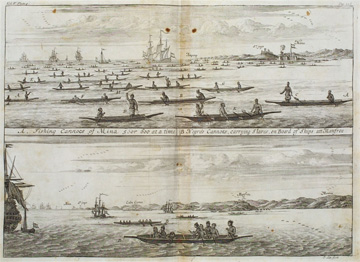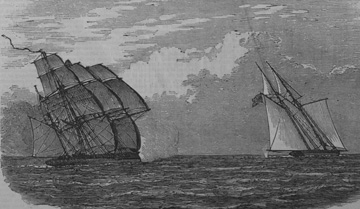Atlantic Ocean


The patterns for sailing ships in and around the Atlantic were first discovered by Spanish and Portuguese pioneers. Their routes soon became familiar to other western Europeans. Initially, Portuguese ships departed Iberian ports for the Canary Islands off the coast of Africa. Here, they picked up trade winds and currents which propelled their sailing vessels across the Atlantic Ocean, entering the Caribbean through the Mona or Dominica passage and from there to Santo Domingo and on to Vera Cruz in Mexico. There, Spanish explorers made contact with indigenous traders and brought home goods from Peru and Mexico. The riches acquired by treasure fleets lured privateers from northern Europe, and obliged Spain to construct elaborate defensive bases in Havana, Cuba, Cartagena, Columbia, and on the island of Santo Domingo. These sailing routes to the Caribbean and Central Americas were well established and used by perhaps one hundred ships per year, even before sugar was introduced in Brazil, thus opening a new phase in the history of the Atlantic.
Seasonal variations in Atlantic winds and currents were crucial, and historians have come to recognize that there were two Atlantic systems linking Europe, Africa, and the Americas. Europeans used the northern Atlantic system, by which they transported Africans to the Caribbean and Central and North America on their sailing vessels. In the southern system, slave traders imported slaves to South America, particularly Brazil. In both cases, trade and the flow of people were determined largely by natural forces of winds and currents.
In the age of sail, European vessels were able to select the path of their voyage around the Atlantic Ocean. Voyages that originated in northern Europe and North America dominated the northern system. Voyages that originated in South America, like Brazil and the Rio de la Plata (dividing present-day Argentina and Uruguay) dominated the southern system. Ship captains were also able to use southeasterly trade winds to quickly cross the Atlantic to South American ports. Northeasterly trade winds took longer to propel ships into the Caribbean and from there north, via the westerlies, to North America.
However slow or fast the Atlantic crossing of European slave ships, it constituted a horrific and traumatic experience for the millions of Africans who endured the Middle Passage. The slave ship crew loaded the captives onto what was in effect a floating prison. This was followed by months of confinement as the ship could linger on the African coast as the captain waited until he had acquired sufficient numbers of captives to make the voyage profitable.
Ships destined to land in Brazil might take only one month to cross the Atlantic, but vessels heading to the Caribbean or North America could take eight weeks or more. Though the sailing time to cross the Atlantic decreased over the history of the Atlantic slave trade, the size of slave ships increased. By the end of the English trade for example, English ships carried an average of 390 Africans. Mortality rates on the ships also fell over time, though the evidence suggests it rose again in the nineteenth century, as smugglers tried to avoid the British Navy’s attempt to suppress the trade. As the British and other Europeans began to legally abolish the slave trade in the nineteenth century, Brazilian, Portuguese, and Cuban slavers carried higher numbers of African captives on their ships. As they escaped the British Navy patrols, the Africans had to endure the consequences of increased sickness and mortality.
History & Memory
Related Pages:
-
 Central Africa
Central Africa
-
 Middle Passage Ceremonies and Port Markers Project
Middle Passage Ceremonies and Port Markers Project
-
 International Slavery Museum
International Slavery Museum
-
 Slave ship model
Slave ship model
-
 Olaudah Equiano
Olaudah Equiano

